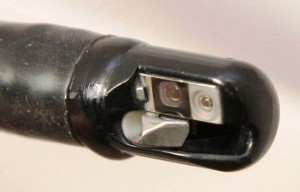December 20, 2019 — Bronchoscopes can pose a risk of infecting patients with life-threatening “superbugs,” even when the devices have been cleaned, a new study suggests.
Almost five years ago, in February 2015, the FDA issued a safety alert warning the public for the first time that duodenoscopes, which are another type of flexible endoscope, can impede effective cleaning and transmit deadly multidrug-resistant bacteria.
 Almost a year later, a U.S. congressional investigation discussed several cases in Seattle, New York and Boston, among other U.S cities, that linked reprocessed duodenoscopes to superbug outbreaks primarily since 2012.
Almost a year later, a U.S. congressional investigation discussed several cases in Seattle, New York and Boston, among other U.S cities, that linked reprocessed duodenoscopes to superbug outbreaks primarily since 2012.
The potential for a “reprocessed” bronchoscope, however, to transmit CRE or a related multidrug-resistant organism, called an MDRO, has been less clearly known and defined both in the literature and by federal U.S. health officials.
This new study, published in the peer-reviewed journal Chest, investigated this risk, and whether it may be an underrecognized concern.
Duodenoscopes are complex in physical design featuring several long and narrow channels, and a forceps elevator mechanism crucial to performing ERCP.
In that February (2015) safety alert, the FDA wrote that this elevator mechanism’s moving parts “contain microscopic crevices that may not always be properly cleaned with a brush,” and that these crevices and related surfaces may remain contaminated after cleaning and disinfection, potentially exposing patients to “serious infections.”
In contrast, flexible bronchoscopes are much simpler in physical design. They feature only one working channel, and they are not equipped with this complex elevator mechanism that can retain bacteria. They may be either reusable and disposable in design.
The FDA defines “reprocessing” as a validated process intended to “remove soil and contaminants” from reusable flexible bronchoscopes and other types of equipment “by cleaning and to inactivate microorganisms by disinfection or sterilization.”
In the past, only reusable duodenoscopes requiring reprocessing were sold in the U.S. Just last week, however, the FDA cleared a disposable duodenoscope for the first time.
Duodenoscopes are used more than 500,000 times a year in the US to perform endoscopic retrograde cholangiopancreatography, or ERCP — a medical procedure used to examine and treat disorders of the bile and pancreatic ducts.
(Article continues below)
 Expert Consulting Services: LFM-Healthcare Solutions, LLC provides medical expertise and guidance for hospitals, manufacturers and the public, specializing in healthcare-associated infections linked to medical equipment.
Expert Consulting Services: LFM-Healthcare Solutions, LLC provides medical expertise and guidance for hospitals, manufacturers and the public, specializing in healthcare-associated infections linked to medical equipment.
(Article continued from above)
A potentially underrecognized and underestimated infection risk
Six months after the FDA published its February safety alert about duodenoscopes, the agency published a safety notice focusing, this time, on bronchoscopes.
According to the agency, the purpose of the notice was “to share preliminary information regarding infections associated with the use of reprocessed flexible bronchoscopes.” This notice added that bronchoscopes are “part of a subset of devices that pose a greater likelihood of microbial transmission and represent a high risk of infection if they are not adequately reprocessed.”
As if a deja vu moment, this August notice also reported that the FDA had learned of instances of “persistent” contamination of bronchoscopes “despite following the manufacturer’s reprocessing instructions.” At that time in 2015, the notice, which has not been updated, reported that these cases were “small” in number.
Whether the number of these types of cases today, almost 5 years later, has increased significantly is a focus of this newly published article in Chest.
While this August safety notice importantly publicized that bronchoscopes can pose an infection risk, it did not answer or clarify, for pulmonologists and other stakeholders, whether reprocessed bronchoscopes had been linked specifically to outbreaks of CRE or a related MDRO.
This study in Chest addresses this question, and its findings suggest not only that bronchoscopes can transmit CRE and related MDROs — a safety concern warranting greater public awareness, enhanced preventive measures, and updated reprocessing guidance, according to this study’s authors — but also that this risk may be underrecognized.
 Underestimating the true risk of infection associated with a bronchoscope (or any reusable medical device) can have significant adverse implications for the public’s safety.
Underestimating the true risk of infection associated with a bronchoscope (or any reusable medical device) can have significant adverse implications for the public’s safety.
For instance, such an oversight could cause healthcare resources originally committed to the bronchoscopy suite, and crucial to the suite’s infection prevention, to be redirected to other departments or disciplines, jeopardizing the safety of bronchoscopy.
This study in Chest was co-authored by the Cleveland Clinic’s Atul Mehta, M.D., and Lawrence F Muscarella, Ph.D., this blog’s writer.
Dr. Muscarella has written possibly the most comprehensive tridental set of articles published in the peer-reviewed literature discussing the risk of flexible endoscopes transmitting multidrug-resistant bacterial infections, including CRE and related MDROs.
CRE are a particularly troubling type of MDRO that are resistant to “last-resort” antibiotics called carbapenems. The mortality rate of infections caused by CRE can be as high as 50%.
Twelve infections identified
The study in Chest identified 12 cases reported since 2013 associating a bronchoscope with infections of CRE or a related MDRO (or with bacteria suspected to be one of these two types).* Eight of these cases occurred in the U.S., four overseas.
This study investigated the details of these 12 cases, including whether the bronchoscope had been reprocessed according to manufacturer instructions; the outbreak’s reported cause; and the measures the facility adopted to prevent additional infections.
Five of the 12 cases reported that the bronchoscope was reprocessed in accordance with manufacturer instructions (or to published guidelines). At least three of these 12 cases were due to CRE.

(Source: FDA)
While the duodenoscope’s complex physical design is a well-recognized risk factor for the transmission of superbugs during ERCP, this Chest study found damage or wear to the bronchoscope, or its inadequate servicing or maintenance, to be more significant contributors to infections associated with these less complex devices.
The formation of resistive, inaccessible biofilms inside the bronchoscope’s channel also can adversely impact reprocessing and pose an increased risk of the device transmitting CRE and related MDROs.
Several of these 12 cases reported that repairing the bronchoscope or removing it from use terminated the outbreak.
Whether colonoscopes, too, like duodenoscopes and bronchoscopes, can pose a risk of transmitting CRE and related MDROs is discussed in the related article, “A Colonoscope is Linked to Two Infections of the Nightmarish ‘CRE’ Superbug.”
Bronchoscopes, duodenoscopes linked to mcr-1 transmission
One of this study’s cases, identified in Asia in 2013, may be the first linking a bronchoscope to infections caused by Pseudomonas aeruginosa carrying the mcr-1 gene. Bacteria with this gene can be resistant to colistin, which is an even more potent “last resort” antibiotic used sometimes when carbapenems are ineffective.
Some colistin-resistant bacterial infections can be untreatable. The FDA has defined CRE and their related MDROs as “high concern organisms.”

According to the authors of this case in Asia, the bronchoscope remained contaminated despite disinfection. Cultures of the reprocessed bronchoscope remained positive for the colistin-resistant bacteria until the device was sterilized weekly using ethylene oxide (EtO) gas, in addition to cleaning and HLD, which terminated the outbreak.
It is suggested that the healthcare professional read the related article, “A Duodenoscope Has Been Linked to Probable Transmission’ of a Colistin-Resistant Superbug.”
Last year, a study reported the first documented case in the U.S. of healthcare transmission of bacteria harboring the mcr-1 gene. According to the authors, this transmission “likely occurred via (a) duodenoscope despite no identifiable breaches in reprocessing or infection control practices.”
P. aeruginosa is a gram-negative bacterium that is commonly found in water and soil and belongs to the Pseudomonadaceae family. While this organism can be resistant to carbapenems (and colistin), it is not CRE, whose strains are necessarily of the different Enterobacteriaceae family.
This study in Chest defines a MDRO “related” to CRE primarily as a gram-negative organism not of the Enterobacteriaceae family, but that demonstrates non-susceptibility to carbapenems or colistin. An example would be P. aeruginosa carrying the mcr-1 gene.
In addition to discussing this case in Asia linking a bronchoscope in 2013 to infections of mcr-1-carrying P. aeruginosa, this Chest study discusses some of the details of the first apparent report linking a bronchoscope a year later, in 2014, to CRE infections in the U.S.
It is suggested that the healthcare professional read these two related articles: “A Bronchoscope Was Linked to a ‘Superbug’ Outbreak in 2014” and “A Bronchoscope is Linked Again in the U.S. to an Outbreak of the Feared ‘CRE’ Superbug.”
(Article continues below)
Thinking about shifting to sterilization? Guidance to assist healthcare facilities deciding to replace disinfection with sterilization of flexible endoscopes is provided in two recently published articles entitled, “What You Need to Know When Replacing Disinfection with Sterilization of Flexible Endoscopes” and “Which Flexible Scopes Really Need Sterilization?“
(Article continued from above)
Disinfection or sterilization?
Bronchoscopes are classified as semi-critical devices, because they routinely contact mucous membranes, but do not ordinarily penetrate sterile tissues or the vasculature system.
Although federal guidelines recommend sterilization of semi-critical devices including bronchoscopes when feasible, high-level disinfection of bronchoscopes has been commonplace for decades.
In a recent article entitled, “Why Are These Medical Instruments So Tough to Sterilize?,” the New York Times discussed the challenges of sterilizing duodenoscopes.
Combining this study in Chest with another article also published this year but focusing on duodenoscopes, a total of 35 outbreaks linking the use of either a bronchoscope or a duodenoscope to possible transmission of CRE or a related MDRO were reviewed and their causes investigated.
This Chest article’s two authors concluded that, “Cases associating bronchoscopes with transmission of CRE and related MDROs were identified, warranting mitigation and updated guidance to reduce this risk.”
Both authors added that, “Several issues remain unresolved including whether the true incidence of post-bronchoscopic infections is significantly higher than estimated.”
* “Associating” or “linking” a bronchoscope or another type of reusable device to or with an infection or an outbreak does not confirm the device transmitted and caused the infection, as one or more other factors could be, in part or completely, responsible. More data would be required to conclude whether a device caused an infection.
Article by: Lawrence F Muscarella, PhD. Posted December 20 2019. Copyright (2019). LFM Healthcare Solutions, LLC. All rights reserved. Dr. Muscarella is the president of LFM Healthcare Solutions, LLC, an independent quality improvement company. Click here for more details about his quality improvement healthcare services.
Contact — Contact Dr. Muscarella for a prompt response: Call | Email | Text | Skype
 Expert Consulting Services: LFM-Healthcare Solutions, LLC provides medical expertise and guidance for hospitals, manufacturers and the public, specializing in healthcare-associated infections linked to medical equipment.
Expert Consulting Services: LFM-Healthcare Solutions, LLC provides medical expertise and guidance for hospitals, manufacturers and the public, specializing in healthcare-associated infections linked to medical equipment.
Thank you for again another highly interesting insight. Do you think that reprocessing should focus more attention on biofilm? This is actually why cleaning is so primordial. There is so much discussion about sterilization, but that wouldn’t be effective either if cleaning is not done properly. How do you feel about this?
Thank you.